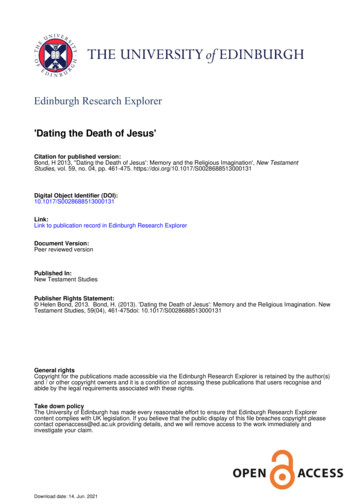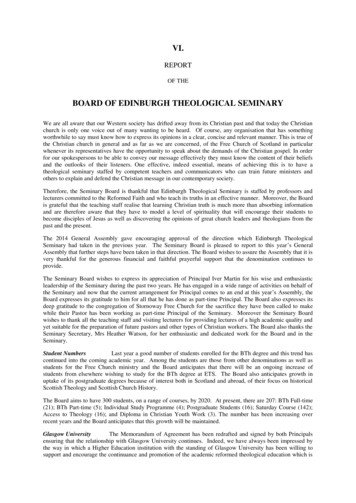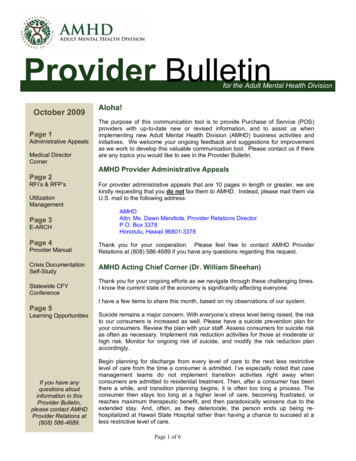
Transcription
Edinburgh Research Explorer'Dating the Death of Jesus'Citation for published version:Bond, H 2013, ''Dating the Death of Jesus': Memory and the Religious Imagination', New TestamentStudies, vol. 59, no. 04, pp. 461-475. https://doi.org/10.1017/S0028688513000131Digital Object Identifier (DOI):10.1017/S0028688513000131Link:Link to publication record in Edinburgh Research ExplorerDocument Version:Peer reviewed versionPublished In:New Testament StudiesPublisher Rights Statement: Helen Bond, 2013. Bond, H. (2013). 'Dating the Death of Jesus': Memory and the Religious Imagination. NewTestament Studies, 59(04), 461-475doi: 10.1017/S0028688513000131General rightsCopyright for the publications made accessible via the Edinburgh Research Explorer is retained by the author(s)and / or other copyright owners and it is a condition of accessing these publications that users recognise andabide by the legal requirements associated with these rights.Take down policyThe University of Edinburgh has made every reasonable effort to ensure that Edinburgh Research Explorercontent complies with UK legislation. If you believe that the public display of this file breaches copyright pleasecontact openaccess@ed.ac.uk providing details, and we will remove access to the work immediately andinvestigate your claim.Download date: 14. Jun. 2021
Dating the Death of Jesus: Memory and the Religious ImaginationHelen K. BondSchool of Divinity, University of Edinburgh, Mound Place, Edinburgh, EH1 2LXh.bond@ed.ac.ukAfter discussing the scholarly preference for dating Jesus’ crucifixion to 7thApril 30 CE, this article argues that the precise date can no longer be recovered.All we can claim with any degree of historical certainty is that Jesus died sometime around Passover (perhaps a week or so before the feast) between 29 and 34CE. The emergence of the Johannine tradition (in which Jesus died on the day ofPreparation) and the Markan tradition (in which Jesus dies on the Passoveritself) are explored through the lens of social/collective memory.Keywords: date, crucifixion, Passover, social memory, paschal lamb, eucharist.‘There is a relatively widespread consensus that Jesus was crucified on April7, 30.’ J. D. G. Dunn, Jesus Remembered (Grand Rapids: Eerdmans, 2003),312.‘Jesus was dead by the evening of Friday, April 7, 30.’ J. P. Meier, Jesus: AMarginal Jew (New York/London: Doubleday, 1991), 402‘As regards Jesus, it is certain that he was crucified in Jerusalem on 7 April 30CE.’ J. Murphy O’Connor, Jesus and Paul: Parallel Lives (Minnesota:Liturgical Press, 2007), 53.‘the fourteenth of Nisan (7 April of the year AD 30) is, apparently in theopinion of the majority of contemporary scholars as well, far and away themost likely date of the crucifixion of Jesus.’ R. Reisner, Paul’s Early Period:Chronology, Mission Strategy, Theology (Grand Rapids: Eerdmans, 1998), 58.‘Thus, I conclude that Jesus died on Nisan 14 (April 7) in A.D. 30.’B. Witherington, New Testament History: A Narrative Account (GrandRapids: Baker Academic, 2001), 134.As these quotations illustrate, the 7th April 30 CE is widely regarded by many modernJesus scholars as the day on which Jesus died.1 Of course, not everybody agrees withthis view. Some favour the year 30 without specifying the precise day or month,2others propose more idiosyncratic dates,3 and a sizeable minority of largely1For a survey of older literature, which similarly favoured 7th April 30 CE, see J. Blinzler, The Trial ofJesus (Cork: Mercier Press, 1959), 72-80.2So G. Theissen and A. Merz, The Historical Jesus: A Comprehensive Guide (London: SCM, 1998),160; E. P. Sanders accepts 30 as a useful approximation, but makes it quite clear that specific dates areimpossible (and not really useful); more broadly he seems to prefer something in the range of 29-30,The Historical Figure of Jesus (London: Penguin, 1993), 54, 282-90.3For example, J. Vardaman argues for Friday Nisan 15, 21 CE (‘Jesus’ Life: A New Chronology’ in J.Vardaman and E. M. Yamauchi [eds.], Chronos, Kairos, Christos: Nativity and Chronological StudiesPresented to Jack Finegan [Eisenbrauns, 1989], 55-82); L. Depuydt argues for 29 (‘The Date of theDeath of Jesus of Nazareth,’ JAOS 122 [2002], 466-80); as does D. J. Lasker (‘The Date of the Death1
conservative scholars favour 33.4 Given the complexities of our sources, however, thelevel of agreement surrounding the date of Jesus’ crucifixion is truly astounding.What I want to do in this paper is (1) to ask how scholars got to the 7th April 30 CE inthe first place, (2) to look at the implications of this date, and (3) to suggest thatscholarly confidence in it is severely misplaced.I Why 7th April 30 CE?All attempts to date Jesus’ death begin with the gospel passion narratives. As is wellknown, the Synoptic and Johannine accounts have both similarities andcontradictions. Both agree on the general sequence of events: that Jesus ate a mealwith his disciples on a Thursday evening, that he was crucified the following day andquickly buried before the approaching Sabbath, and that the tomb was found to beempty on the Sunday morning. The major chronological discrepancy between the twoaccounts lies in the precise way in which events map onto the Passover. In Mark, bothJesus’ last meal and his death take place on the feast day itself, while in John bothevents take place on the day of Preparation (Jn 19.14, 18.28, 19.31).5 Thus bothtraditions agree that Jesus was crucified on the Friday and buried that afternoon, thequestion revolves around whether that Friday was the Passover itself, Nisan 15 (soMark), or the day of Preparation, Nisan 14 (so John).One approach to this problem is to harmonise the two traditions, to suggest that Johnand the Synoptics simply used different calendars. Perhaps the most famous exponentof this method was Annie Jaubert who, in a series of studies from the 1950s, famouslysuggested that Jesus and his disciples followed not the by now dominant Babylonianlunar calendar, but an old solar calendar evident in the books of Enoch and Jubileesand used at Qumran.6 More recently, Colin Humphreys argued that Jesus and hisdisciples used a pre-exilic lunar calendar which, he claims, was still used byGalileans.7 All attempts at harmonising the two traditions, however, are beset by thesame four problems:of Jesus: Further Reconsiderations,’ JAOS 124 [2004], 95-99); and N. Kokkinos suggests Friday Nisan14, 36 (‘Crucifixion in AD 36: The Keystone for Dating the Birth of Jesus,’ in J. Vardaman E. M.Yamauchi [eds.], Chronos, Kairos, Christos, 133-64).4When combined with Lk 3.1-2, this date allows for the longer, Johannine reckoning of a two or eventhree year ministry. See for example, J. K. Fotheringham, ‘The Evidence of Astronony and TechnicalChronology for the Date of the Crucifixion,’ JTS 35 (1934), 146-62; H. Hoehner, ChronologicalAspects of the Life of Christ (Grand Rapids: Zondervan, 1977), 65-114; J. Finegan, Handbook ofBiblical Chronology: Principles of Time Reckoning in the Ancient World and Problems of Chronologyin the Bible (rev. edn. Massachussetts: Hendrickson, 1998), 353-369; P. Barnett, The Birth ofChristianity: The First Twenty Years (Grand Rapids: Eerdmans, 2005), 24-25, who admits that 33 is a‘minority view’; and C. J. Humphreys, The Mystery of the Last Supper: Reconstructing the Final Daysof Jesus (Cambridge: CUP, 2011). R. E. Brown declares himself unable to decide between 30 and 33,The Death of the Messiah (New York/London: Doubleday, 1994), 1376.5The Passover in John’s scheme fell on the Sabbath that year, making the day following the crucifixiona particularly ‘high day’ (19.31).6A. Jaubert, ‘La date de la derniere Cène,’ Revue de l’Histoire des Religions, 146 (1954), 140-73; alsoLa date de la Cène – Calendrier Biblique et Liturgie Chrétienne (Etudes Bibliques, Paris, 1957).7C. J. Humphreys, Mystery of the Last Supper, 110-50. This ancient calendar, he argues, calculated thenew month not from the visibility of the new crescent (as the Babylonian calendar did) but from theday of conjunction, and hence started its new days at sunrise.2
First, there is little evidence for any widespread use of alternative calendars infirst century Palestine. In a thorough overview of the much-fêted Qumrancalendar, Jonathan Ben-Dov and Sephane Saulnier show that recentscholarship has concluded that the calendar was neither strictly lunar nor solar,but rather composed of a rigid 364 day year.8 The fact that this calendar madeno provision for intercalations is problematic, and, as Sasha Stern points out,prolonged use over an extended period of time would have quite substantiallysevered the link between agricultural festivals and the cycle of the crops. In allprobability, he suggests, schematic calendars such as that at Qumran (and alsothose of 1Enoch 72-82 and Jubilees) served not as living calendars, but asidealistic or theoretical models related to a future world order. In Stern’s view,calendrical sectarianism had ceased by the first century.9 Second, Jesus’ teaching shows no interest in the calendar, and both Jesus andhis early followers in Acts appear to have visited the Temple at exactly thesame time as other Jews. If they routinely used a different calendar, it isstrange that it does not show up elsewhere in the tradition.10 Third, if Jesus had celebrated the Passover according to a different calendar, itseems very odd that one of his followers (usually thought to be John) blatantlydated the last events in his master’s life not by his preferred system ofreckoning, but by that used by his chief priestly opponents. Finally, one further difficulty with the theories of Jaubert and Humphreys inparticular is that by their reckoning the Last Supper was celebrated on either aTuesday (so Jaubert) or a Wednesday (so Humphreys). Yet we have alreadyseen that one of the few things that the Synoptic and the Johannine traditionsagree on is that Jesus’ last meal took place on a Thursday. By attempting tosolve one discrepancy, these reconstructions have created another.More plausible, perhaps, is the suggestion that the discrepancy lies in a difference indating between Palestine and the Diaspora. Since the Passover was calculatedfollowing the sighting of the new moon (as we shall see below), and since there doesnot seem to have been a centralised body to endorse one particular calendar at thispoint (at least as far as we know), diversity could have existed amongst variousJewish groups.11 It is possible that Jews in Palestine observed Passover on Saturdaythat particular year, and that those in certain areas of the Diaspora may havecelebrated it on Friday. In view of this, M. H. Shepherd suggested that John followedthe testimony of Christians in touch with priestly circles in Judaea, while Markfollowed traditions endorsed by his own Roman church.12 The difficulty with such ahypothesis, however, is that we would imagine that anyone making the journey toJerusalem would automatically follow the Judaean calendar, celebrating the feast with8See J. Ben-Dov and S. Saulnier, ‘Qumran Calendars: A Survey of Scholarship 1980-2007,’ CBR 7(2008), 124-68.9S. Stern, Calendar and Community: A History of the Jewish Calendar 2 nd Century BCE – 10thCentury CE (Oxford: OUP, 2001).10This point is also made by G. Theissen and A. Merz, The Historical Jesus, 160.11S. Stern, Calendar and Community, 116-9.12M. H. Shepherd, ‘Are Both the Synoptics and John Correct about the Date of Jesus’ Death?’ JBL 80(1961), 123-32.3
the rest of the city. All traditions and recollections of events would simply follow theJerusalemite dating. It is difficult to see why they would be transposed onto a calendarused by Roman Jews, particularly if the differences were simply to do withobservation rather than sectarian debates.Faced with these significant difficulties, most scholars accept that we simply have tochoose between the two options. But which one - John or the Synoptics? Somewhatsurprisingly, perhaps, recent scholars have tended to give preference to John.13 At firstsight, John’s scheme has two great advantages over that of the Synoptics: first, John’saccount is internally consistent while Mark’s (as we shall see in a moment) is riddledwith difficulties. Second, John’s low-key account of Jesus’ informal Jewish hearingon the day of Preparation chimes much more harmoniously with what we know ofJewish jurisprudence in the first century than the Synoptic record of a grand meetingof a Sanhedrin convening a capital case on the very night of Passover.14Thus, by a significant modern consensus, the date of Jesus’ death was 14th Nisan, andthe task of the historian is to work out on what years the 14th Nisan fell on a Fridayand then to convert it to the Julian calendar to give a date which is meaningful to us.The timescale can be narrowed quite considerably: if we accept the historicity of Luke3.1 (which dates the beginning of John the Baptist’s ministry to 28 at the earliest) andbalance against this the need to fit in Pauline chronology, Jesus’ death must havetaken place some time between 29 and 34 CE.15 The question then becomes morestraight-forward: are there any years between these margins when the day ofPreparation fell on a Friday?There are two ways of solving this puzzle: while an earlier generation of scholarsrelied on ancient calendrical tables,16 modern scholars have the benefit of computers.Whichever method is employed, however, astronomers can pinpoint the beginning ofthe months in the first century by locating the lunar conjunction (when the moon isbetween the earth and the sun) and then, by adding two weeks, find a date for thePassover full moon.17 There are of course a number of complications. The beginning13While Joachim Jeremias famously supported Mark’s dating (The Eucharistic Words of Jesus[London: SCM, 1966], 20-33), a majority of more recent Jesus scholars have favoured John: J.Blinzler, Trial of Jesus, 101-8; R. E. Brown, Death, 1351-73; J. P. Meier, Marginal, 1:3
Dating the Death of Jesus: Memory and the Religious Imagination Helen K. Bond School of Divinity, University of Edinburgh, Mound Place, Edinburgh, EH1 2LX h.bond@ed.ac.uk After discussing the scholarly preference for dating Jesus’ crucifixion to 7th April 30 CE, this article argues that the precise date can no longer be recovered. All we can claim with any degree of historical certainty is .











